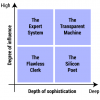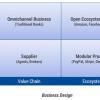Business Transformation Requires Transformational Leaders
Leadership and teaming skills are front and center in times of rapid change. Meet today’s constant disruption head on with expert guidance in leadership, business strategy, transformation, and innovation. Whether the disruption du jour is a digitally-driven upending of traditional business models, the pandemic-driven end to business as usual, or the change-driven challenge of staffing that meets your transformation plans — you’ll be prepared with cutting edge techniques and expert knowledge that enable strategic leadership.
Subscribe to Arthur D. Little's Culture & Leadership Newsletter
Insight
AI and the Consequences of Empowering the Machine
If we believe AI to be a threat to our civilization, it must introduce some substantial risk that is different from the risks that we are already exposed to. Does AI really introduce a new risk? Do machines that incorporate AI pose a threat to human existence? This Executive Update attempts to answer that question.
Trust Building in Agile Teams
One can argue that Agile methods do not pay off without trust to oil the wheels.
What’s Next for Banks?
The main threat for banks does not come from outside but from within. It is not the fintech companies that are the biggest danger. On the contrary, they offer many new and fresh ways of working that traditional banks would never have thought of. The biggest danger for banks is their difficulty in quickly adapting to this changing landscape, opening up, and determining whom to collaborate with, acquire, ignore, or compete against.
Faced with a cross-section of seemingly disparate business and technology demands, one would logically ask how a business can concurrently execute a multiheaded set of strategies against operating models that are at best opaque and at worst driving companies out of business. The answer requires breaking down a business to its basic building blocks, which in turn provides a common lens through which to view and align business objectives, initiatives, and related investments.
Business models are being disrupted across industries by savvy new entrants to markets who are leveraging emerging technologies and the latest digital practices. How is your executive team responding to technology-driven turbulence in your industry and in your marketplace?
Blockchain Rising, Part V: Domains and Industries of Greatest Impact
This Executive Update centers on recent Cutter survey findings pertaining to the domains and industries where blockchain technology will have the most significant impact.
If the right measures are put in place, following the digital trace enables transparency, traceability, and objective insight.
The ease of obtaining, copying, and implementing digital assets means that there is potential for rapid changes in nearly all disruptive business models. This ability to change rapidly is reflected in the enterprise architecture itself, which tends to be relatively simple, modular, and responsive.













